Undergraduate Research
Asking questions and taking risks
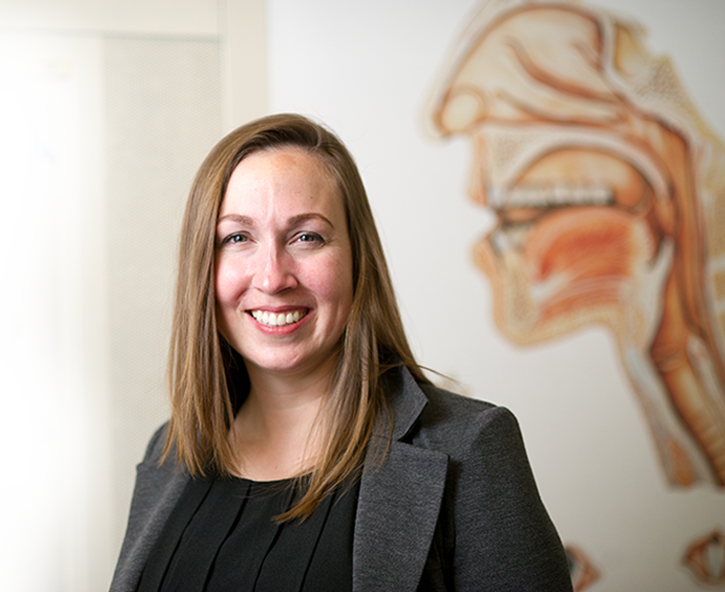
Undergraduates and Cara Stepp’s Speech Disorders & Engineering Lab:
it’s a win-win
Stepp teaches students how to do hands-on research—and they help make her lab go
When Cara Stepp got an email from Boston University freshman Carolyn Michener (SAR’16) pleading to join her lab, the College of Health & Rehabilitation Sciences: Sargent College assistant professor of speech, language, and hearing sciences was torn. “I already had too many undergrads—10 or 11 and not enough room for them all to sit,” recalls Stepp, who holds joint appointments in otolaryngology at the School of Medicine and in biomedical engineering at the College of Engineering. But as evidenced by her crowded quarters, Stepp has a hard time turning away enthusiastic undergraduates, and she was intrigued by Michener’s interest in both speech pathology and engineering. Stepp’s Sensorimotor Rehabilitation Engineering lab uses neural, electrical, and mechanical engineering to study normal and disordered speech and develop technological therapies to treat the latter. A week after Michener sent the email, she had a place in Stepp’s lab.
That was in 2013. With funding support from the University’s Undergraduate Research Opportunities Program (UROP), Michener has worked on several projects, gotten her name on a half-dozen papers, presented at academic conferences, won an undergraduate research award from the American Speech-Language-Hearing Association, and been exposed to every step of the research process, from developing technology to interacting with subjects to analyzing data.
Michener belongs to the small army of students that Stepp has guided through her lab, and counted on, over the years. They are part of her strategy for working most efficiently—everyone has a specific task that’s appropriate for their level of academic experience, so no one is doing more or less than they should. At the same time, the undergraduates get a chance to participate in meaningful scientific research before they sign up for the long haul.
“Undergrads have so much potential and typically less knowledge. You can often make a huge impact on what they understand and accomplish with just a tiny bit of attention and information,” says Stepp, who is a Peter Paul Career Development Professor and a junior faculty fellow with the Rafik B. Hariri Institute for Computing and Computational Science & Engineering. “And it is incredibly fun to watch them realize that they like science or engineering when they didn’t realize it before.”
Stepp is personally familiar with that discovery process; she came to her own such realization while doing electrical engineering research as an undergraduate at Smith College. “I got there thinking I wanted to be an environmental engineer, specifically on the chemical side,” she says, but after two years of working in the lab of her chemical engineering professor, she discovered it wasn’t for her. Maybe the problem wasn’t research itself, but the subject matter. Or maybe, Stepp hazards, “I just didn’t have the tools to see what I was interested in yet.” Then, just before her senior year, she enrolled in a class called Signals and Systems, and it changed the course of her life and career. The class forced her to think about “black boxes”—engineering lingo for systems where the internal workings are not easily observed, like the inner ear. She had to think about what happens inside those boxes based only on the signals that go in and the responses that come out. The professor, an electrical engineer, urged Stepp to do a research project for her senior thesis. “Even though I thought I didn’t like research,” Stepp says, “I decided to give it a try.” She loved it.
 The Stepp Lab uses a measure called “relative fundamental frequency” (RFF) to track voice changes. First, the researchers record their subjects vocalizing nonsense words. These recordings are translated into visual representations (pictured here), which show the actual sound wave of the speaker’s voice. Marking the changes in frequency that occur between vowel and constant sounds lets researchers compare the fundamental frequencies between voices, potentially revealing useful differences between people with voice disorders and their healthy counterparts.
Image courtesy of Cara Stepp
The Stepp Lab uses a measure called “relative fundamental frequency” (RFF) to track voice changes. First, the researchers record their subjects vocalizing nonsense words. These recordings are translated into visual representations (pictured here), which show the actual sound wave of the speaker’s voice. Marking the changes in frequency that occur between vowel and constant sounds lets researchers compare the fundamental frequencies between voices, potentially revealing useful differences between people with voice disorders and their healthy counterparts.
Image courtesy of Cara Stepp
She loaded up on electrical engineering classes in her final year of college, then went on to the Massachusetts Institute of Technology to earn a master’s in electrical engineering and then a doctoral degree in biomedical engineering at the Harvard-MIT Division of Health Sciences and Technology. She did her postdoctoral research at the University of Washington.
Today, Stepp is still thinking about boxes—specifically those having to do with the human speech system. The larynx and the middle ear, for instance, are two systems that are difficult to observe in real time. So Stepp and her team create ways to measure outputs, such as muscle electrical activity or breath strength, that can reliably describe what happens inside the black box. Consider patients with Parkinson’s disease. The neurological disorder is typically associated with tremor and gait problems, but roughly 90 percent of patients also suffer from voice and speech problems, Stepp says. “The primary symptom people notice is something called hypophonia or hypokinetic dysarthria. And basically what that means is that everything is smaller.” Mouth movements are smaller; voice volumes are lower. “Being less loud and under-articulating things makes them less clear, and that results in reduced intelligibility,” Stepp says. She and her students are examining how deficits in these patients’ sensory and auditory systems might predict the speech problems associated with Parkinson’s. To do so, they’re looking at hearing function of the inner ear using some of the very tools her undergraduate advisor taught her back at Smith.
 Stepp uses human-machine interfaces (HMIs) to study how alternative forms of feedback can aid rehabilitation. Her lab is developing an HMI that employs auditory feedback instead of eye-tracking, using electrodes placed on the skin, like those pictured here, to detect subtle facial-movement muscles.
Photo by Michael D. Spencer
Stepp uses human-machine interfaces (HMIs) to study how alternative forms of feedback can aid rehabilitation. Her lab is developing an HMI that employs auditory feedback instead of eye-tracking, using electrodes placed on the skin, like those pictured here, to detect subtle facial-movement muscles.
Photo by Michael D. Spencer
In another project—the first Michener got to work on—Stepp’s lab is trying to create a communication tool for people with spinal cord injuries. “These individuals will often use an eye-tracking device or something similar to control the computer they use to communicate,” Michener says. “But that’s not necessarily useful for people who are visually impaired. Those patients may better benefit from auditory feedback.” She and others in the Stepp lab created a human-machine interface that uses electrodes on the skin to detect subtle movements of facial muscles. Those movements allow the patient to control an on-screen cursor while receiving auditory feedback in the form of different pitches. The auditory feedback allows the user to know where they are in a virtual 2D space, Stepp explains. “For a seeing person, that would be like a cursor on a screen. In this case the ‘auditory cursor’ position is signaled to the user by distinct changes in the pitch and localization cues (changes in the left-right headphone feedback that make the sound come from the left, center, or right),” she says.
Since Stepp was a postdoc, she has been using human-machine interfaces like this, as well as robotic devices, to study how alternative forms of feedback can aid rehabilitation. She knew from her own experience how valuable research could be for those students—and for scientists, too. The students made it possible for her to take on projects that she couldn’t have tackled alone.
Now, as a principal investigator in charge of her own lab, Stepp still sees this value and has built it into her research program. It’s a system: students arrive with little to no experience and often leave with multiple publications to their names. They spend their first month as volunteers, learning the basic tools of the trade—the anatomy and physiology of voice and speech, for instance, or how to teach and test human subjects and analyze acoustics. Then they are matched with a postdoctoral researcher or a graduate student and they get to work, often on a number of different projects and for academic credit. It’s a win-win.
“There’s a steep learning curve,” Stepp says. “You have to figure out what tasks you can give someone that they have the tools to do, without you doing it for them, but isn’t just counting things.”
In the end, there is a fair bit of counting—or clicking, as the case may be. On a typical day, Stepp’s lab hums with a steady symphony of mouse clicks. An assortment of postdocs, graduate students, undergrads, and even high school students is packed into a small room lined with computers to analyze audio files. Some wear headphones while listening to study subjects say nonsense words: “afa,” “efe,” “ufu.” Others examine visual representations of those sounds: black sound waves on a pink screen. Still others develop new software to do specific analyses never attempted before.
On a recent day, Michener has just finished “cropping” a file for her senior thesis. With every click of her mouse, she marks a transition between vowel and consonant sounds, highlighting the pieces of speech she can use to search for a reliable measure of voice strain among severely disordered speakers. Michener has recognized since childhood how frequently we take communication for granted. “The average person doesn’t realize how difficult it can be to live life on a day-to-day basis with a speech disorder,” she says, a slight stutter interrupting her own words.
Everyone has tedious jobs when it comes to research, Stepp says, even her. But undergrads also get to do some of the most innovative, cutting-edge projects because they are just too risky for grad students or postdocs.
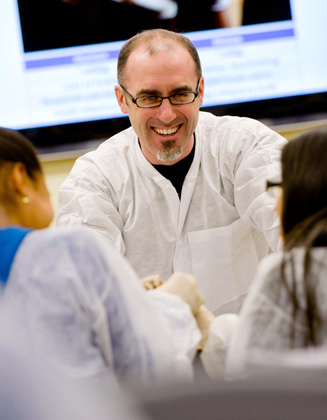 Paul Lipton, director of UROP.
Photo by Kalman Zabarsky
Paul Lipton, director of UROP.
Photo by Kalman Zabarsky
“Postdocs are at a point in their careers where they can’t fail; their professional development is dependent on success,” says Paul Lipton, director of UROP and the undergraduate neuroscience program. Similarly, grad students are in time-limited apprenticeships, he says, which depend on successful completion of a project. “But with undergrads, there is no risk—not publishing is not a detriment to their careers.”
As federal funding for scientific research becomes tighter and tighter, Lipton explains, risky grant proposals are often turned down unless they include pilot data. But getting pilot data is tricky if no one in the lab can afford to fail. For an undergraduate, just engaging in the process is valuable, regardless of the project’s outcome. So faculty can pursue projects they might otherwise avoid, while an undergrad learns something about herself and whether she wants to go on to graduate school. “Having an extra pair of hands is indispensable in being able to ask the risky questions,” Lipton says.
One risky project is the smartphone app being developed by Michener’s labmate, Kate Girouard (ENG’17), which aims to standardize and quantify voice therapy interventions and outcomes. Stepp lab graduate student Liz Heller Murray had already developed a paper-based method to collect background information on a patient, record discussions, and devise treatment plans. The paper version works well, but Girouard hopes it will work better with the help of her app. Less cumbersome paperwork might encourage more clinicians to use it. Then again, it might not. This is the sort of project that must be built before it can prove itself—so it’s perfect for an undergrad.
Girouard loves programming; it was one of the big reasons she was attracted to Stepp’s lab in the first place. “It’s very logical. Everything that appears on the screen or happens behind the scenes is because something else happened before, because you coded it that way,” she says, relishing the order of the process. But now that she’s had the opportunity to apply her programming skills in an actual research setting, she sees it more as a tool than as an end in itself. “It’s invaluable to be able to write code,” she says, “but for me, the research is more exciting. You get to ask your own questions and see the results.”
That’s exactly what she got to do in her first project with the lab, which she undertook with funding from UROP. This was the more traditional project, the kind that just needs to get done. (The kind that Stepp might call tedious.) Girouard had to spend hours cropping voice data files, just like Michener is doing for her senior thesis. Despite the monotony of such a task, Girouard wouldn’t call it boring at all. “I had to learn how to use the computational programs to analyze the acoustic data. But because I’m not a speech pathology major, I was also learning in the background how the recordings are done, what speech looks like—the physiology and anatomy of the speech system. It was a lot of learning.” And from there, she was able to ask her own research question, collect data about it, and analyze those data.
Michener has come a similarly long way since those first days as a freshman in Stepp’s lab. Now, instead of asking questions about how a particular piece of equipment works or why she’s using it, she is pursuing a unique question that extends the work of the lab into new territory. She wants to know whether the standard measures the lab uses to study disordered speech can be used with populations whose speech disorders are so severe that their voices don’t have many of the common features that those standard measures rely on. She couldn’t have even conceived of this project without the years of experience she now has under her belt, but as one of the first students in Sargent College to pursue a senior research thesis (the option only recently became available to Sargent students), she is spending an entire year on it.
Doing research in Stepp’s lab has given Michener the opportunity to take her classroom learning into the real world and solidify it through practical, hands-on application. It’s given a context to her course work and taught her to question everything around her—even the standard lab protocols. She next plans to get more experience in clinical practice to add even more context to her research. Michener isn’t sure yet where her career will take her, but it will almost certainly involve asking questions. “There’s just so much out there we don’t know yet; it really just takes somebody to ask a question to change the world,” she says. Then she turns back toward the computer and keeps cropping.
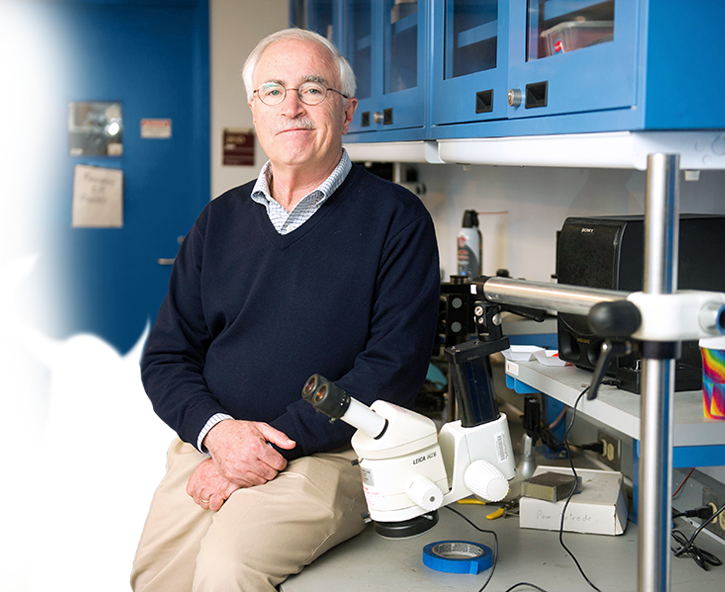

the magic
of Howard Eichenbaum’s Cognitive Neurobiology Lab
Howard Eichenbaum, a College of Arts & Sciences professor of psychological and brain sciences and director of Boston University’s Center for Memory & Brain, is a living legend when it comes to undergraduate research at BU. Students from the neuroscience program—which is heavily focused on research—flock to his cognitive neurobiology lab. He’s been engaging undergraduates for decades, ever since he was a postdoc at MIT. BU Research caught up with Eichenbaum, who is also a William Fairfield Warren Distinguished Professor, to find out how his own undergraduate research led to his career studying the brain and memory, and why he thinks it’s so important for today’s students to get hands-on experience in the lab.
- BU Research: Don’t all science students take lab courses? How is research experience different from that?
- Eichenbaum: In a laboratory course, you follow a cookbook. You basically go through a recipe of steps, succeed or fail at them, write them up in a pretty stereotyped way, and complete it all in one afternoon. But real research has numerous qualities that are different than that. Things stretch out over weeks or months, you have to learn a whole bunch of techniques, many that couldn’t possibly be done in one afternoon, and you have to learn a whole body of detailed knowledge to understand why you’re doing the experiment and appreciate the hypothesis that’s being tested. Then comes the data analysis, which can be just as difficult as performing the experiment itself.
- So it’s pretty important.
- It’s incredibly important. Having an extended period in the lab—over a whole semester, or better yet, a whole year or years and summers and so on—is intensely valuable for students. In fact, I think it’s probably fair to say—and I advise all my students this way—if your direction is to go to grad school, it’s become pretty much essential that you participate in undergrad research.
- Did you do research when you were an undergraduate?
- Yes, I did and I found it tremendously valuable. I was at the University of Michigan, and the first research I did was in social psychology doing biochemical analyses during my senior year. I became connected with some faculty in the psychology department who were doing neuroscience research. I stuck around after my senior year to be a full-time tech in their laboratory. That lasted a year and I then entered the graduate program at Michigan. So the research I did as an undergrad led me directly to the work I’m doing now, which is essentially how the brain stores and organizes memories.
- What are some of the specific questions you and your students are interested in?
- Our focus these days is on primarily two qualities of everyday memory. One is the ability to organize spatial memories: you come into your office and remember where you put this file or that file, or who you were talking to in the office yesterday. That sort of thing. The second property of our everyday memory that’s really special is the ability to reproduce the sequence of events that compose a memory. If I asked you what you did this morning, you can pull it back up again like a little movie in your head of getting out of bed and eating breakfast and taking a shower and the things you did on your way to work. And so we try to study how some of the critical brain structures capture that information in their activity patterns.
- How are the undergraduates involved?
- Each undergraduate student is assigned to a project of one of the grad students. It’s a nice sort of symbiosis. The undergraduate student is essentially preparing the experiments or doing certain steps in the data analysis that a smart kid can pick up in an afternoon. The grad student benefits by having this person who’s an expert in a few pieces of the experiment. And the undergrad benefits by being fully engaged in the process.
- How do you make sure they’re fully engaged?
- Right off the bat, they’re sent home with a few papers to read. They spend time with the grad student discussing what the whole experiment is about and the steps they’ll be going through. The grad student invests a significant amount of time making sure the undergrad understands what the question is that we’re asking and why we’re asking it, how we’re trying to answer it in this experiment. Then they walk them through the procedural steps that the undergrad will be working on while they’re here. You have to come up with the right balance of work that the undergrad will find rewarding.
- It can’t just be washing dishes or something.
- What’s the best way for students to get into a lab?
- As I begin to see students’ interests emerging in the classroom, I tell them they should just pick a project—it doesn’t have to be their life’s project, just something that interests them. I tell them to make contact with a faculty member and essentially take out a one-semester contract, which is to enter the lab and see what they can get going. If it’s right for you, you really get this sort of gut feeling whether you like doing it. At the end of the day, you walk out and say, “Well, even though I was frustrated and nothing worked, I still had fun.” That’s the acid test: Did you feel it was valuable and do you enjoy actually doing this kind of work? I don’t think there’s really any way you can just read journal articles or textbooks and know whether you’d like to do research. I think you have to actually do it.
- Have you had students who’ve come to the lab and realized that it’s totally not for them? How do you spin that into being a good experience?
- Absolutely. That’s why getting into the laboratory and really doing it and feeling it is so important. Because of course there are two outcomes: You can either love it or say, “This is not for me,” and they’re both valuable. I just try to steer those students to what their next adventure will be. Honestly, I think you’d be very lucky to enter your first laboratory and say, “This is what I want to do with my whole life.” More likely, you’ll go through a few labs before landing on the right one, and that’s sort of direct research in its own right, isn’t it? You learn a lot from one experience and often that gives you clues about what to go on to next.
- Which is what you did…
- Which is really kind of what I did, right.
A: That’s right, it has to be some part of the experiment where they feel fully engaged and rewarded. So they’re working on little pieces of the recipe, so to speak, but they see the whole cake being cooked along the way.
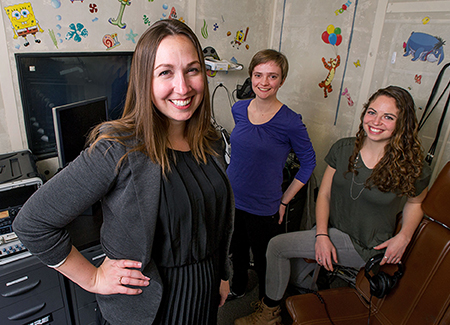

 Francesca
Francesca Joseph
Joseph James
James
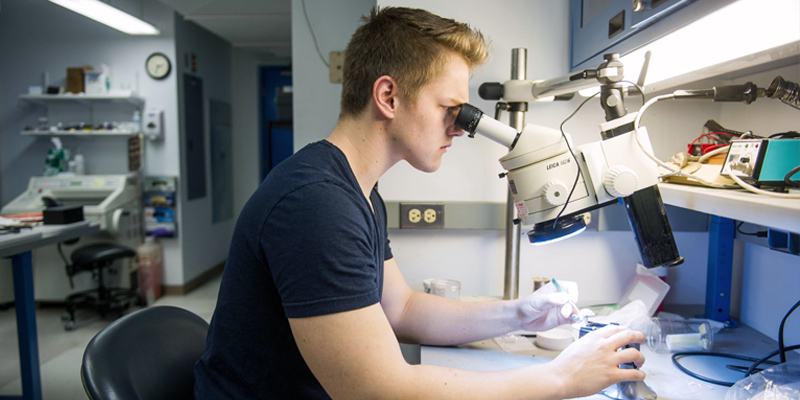

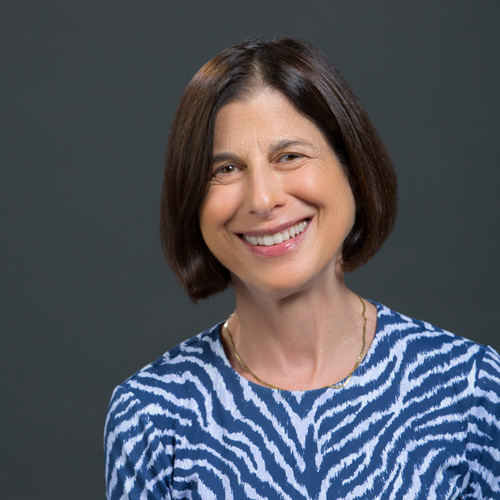
Comments & Discussion
Boston University moderates comments to facilitate an informed, substantive, civil conversation. Abusive, profane, self-promotional, misleading, incoherent or off-topic comments will be rejected. Moderators are staffed during regular business hours (EST) and can only accept comments written in English. Statistics or facts must include a citation or a link to the citation.